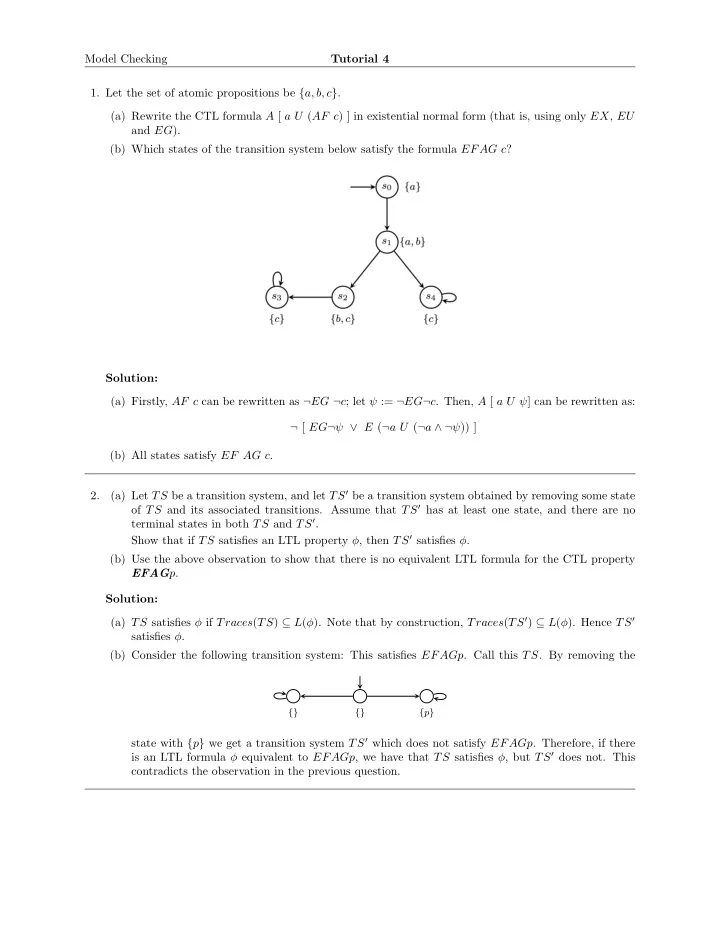

Model Checking Tutorial 4 1. Let the set of atomic propositions be { a, b, c } . (a) Rewrite the CTL formula A [ a U ( AF c ) ] in existential normal form (that is, using only EX , EU and EG ). (b) Which states of the transition system below satisfy the formula EFAG c ? Solution: (a) Firstly, AF c can be rewritten as ¬ EG ¬ c ; let ψ := ¬ EG ¬ c . Then, A [ a U ψ ] can be rewritten as: ¬ [ EG ¬ ψ ∨ E ( ¬ a U ( ¬ a ∧ ¬ ψ )) ] (b) All states satisfy EF AG c . (a) Let TS be a transition system, and let TS ′ be a transition system obtained by removing some state 2. of TS and its associated transitions. Assume that TS ′ has at least one state, and there are no terminal states in both TS and TS ′ . Show that if TS satisfies an LTL property φ , then TS ′ satisfies φ . (b) Use the above observation to show that there is no equivalent LTL formula for the CTL property EFAG p . Solution: (a) TS satisfies φ if Traces ( TS ) ⊆ L ( φ ). Note that by construction, Traces ( TS ′ ) ⊆ L ( φ ). Hence TS ′ satisfies φ . (b) Consider the following transition system: This satisfies EFAGp . Call this TS . By removing the {} {} { p } state with { p } we get a transition system TS ′ which does not satisfy EFAGp . Therefore, if there is an LTL formula φ equivalent to EFAGp , we have that TS satisfies φ , but TS ′ does not. This contradicts the observation in the previous question.
Model Checking Tutorial, Page 2 of 3 3. The F operator in LTL is used to say that a property is true sometime in the future . Let us now introduce the O operator (short form for Once ) to say that a property was true sometime in the past . The formal semantics of O can be defined as follows. For an ω -word α , let α i denote the suffix of α starting from the i th position. Then: α i | ∃ j ≤ i s.t. α j | α 0 | = O φ if = φ and α | = O φ if = O φ Let p 1 and p 2 be atomic propositions. Take the alphabet B 2 = { � 0 � � 0 � � 1 � � 1 � } where the top element , , , 0 1 0 1 indicates the value for p 1 and the bottom one indicates the value of p 2 . Let Ψ := G ( p 1 → O p 2 ). i) Give two examples of ω -words over B 2 : one which satisfies Ψ and one which does not satisfy Ψ. ii) Show that Ψ can be rewritten into an equivalent LTL formula which uses only the standard Until operator U and the boolean connectives ( ¬ , ∧ , ∨ , → ). Solution: (a) { p 2 } ω satisfies Ψ, { p 1 } ω does not satisfy Ψ. (b) Let us look at the negation of Ψ. A word satisfies ¬ Ψ if there exists a p 1 at some position i , and there is no p 2 in the interval [0 , i ]. This corresponds to the LTL formula ¬ p 2 U ( ¬ p 2 ∧ p 1 ). Therefore, Ψ is the negation of this formula: ¬ ( ¬ p 2 U ( ¬ p 2 ∧ p 1 )) 4. Draw the ROBDD for the following boolean functions, with the specified order for variables: (a) x.y + x.y with order [ x, y ] (b) ( x + y ) .z with order [ x, y, z ] Solution: x y x z y y 1 0 0 1
Model Checking Tutorial, Page 3 of 3 5. Represent the following transition system as an ROBDD. 0 1 Solution: x x ′ 0 1
Recommend
More recommend